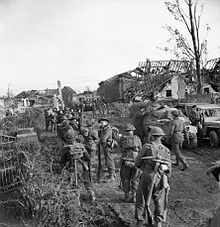43rd (Wessex) Infantry Division
The 43rd (Wessex) Infantry Division ( German 43rd (Wessex) Infantry Division ) was a division of the British Territorial Army which was used in the First and Second World Wars .
history
Constellations
In the course of the army reform of the Secretary of State for War , Richard Haldane , the 43rd Division was set up for the first time in April 1908.
A few weeks after the outbreak of the First World War , the division was embarked on September 24, 1914 for British India to replace regular units there that were intended for use in Europe. From October 9, 1914, their contingents arrived in India, but were then intended for use in the Middle East. In May 1915 the brigades of the 43rd (Wessex) Division were reorganized and prepared for their use on the Mesopotamian Front .
- 128th (Hampshire) Brigade
- 129th (South Western) Brigade
- 130th (Devon and Cornwall) Brigade
When the Territorial Army was reorganized after the end of the First World War, the 43rd Division was also reorganized in 1920. When the Territorial Army was doubled as a result of the new war in 1939, the 43rd Division formed a second line duplicate, the 45th (Wessex) Infantry Division .
1944
After landing in Normandy, the Wessex Division fought from June 26, 1944 as part of the VIII Corps in the costly Battle of Caen in the following organization:
129th Infantry Brigade (Brigadier GHL Luce)
- 4th Battalion, Somerset Light Infantry
- 4th Battalion, Wiltshire Regiment
- 5th Battalion, Wiltshire Regiment
- 94th (Dorset and Hampshire) Field Regiment, Royal Artillery
130th Infantry Brigade (Brigadier ND Leslie)
- 4th Battalion, Dorsetshire Regiment
- 5th Battalion, Dorsetshire Regiment
- 7th Battalion, Hampshire Regiment
- 112th (Wessex) Field Regiment, Royal Artillery
214th Infantry Brigade (Brigadier H. Essame)
- 1st Battalion, Worcestershire Regiment
- 5th Battalion, Duke of Cornwall's Light Infantry
- 7th Battalion, Somerset Light Infantry
- 179th Field Regiment, Royal Artillery
32nd (Guards) Brigade (Brigadier GF Johnson)
- 1st Battalion, Welsh Guards
- 3rd Battalion, Irish Guards
- 5th Battalion, Coldstream Guards
The division was the first to cross the Seine and fought in Operation Market Garden in late September . Deployed as part of the XXX Corps, the 43rd Division had to support the advance of the Guards Armored Division , but the planned capture of the Arnhem Bridge failed . After Market Garden, the 214th Brigade took part in the attack of the 84th US Division in Operation Clipper and intervened with a small contingent in the Allied counter-offensive in the Battle of the Bulge .
1945
In January 1945 she fought in Operation Blackcock (conquering the 'Rur triangle' between the cities of Roermond , Sittard and Heinsberg from January 14th to 26th, 1945). Operation Plunder began on March 23, 1945 , as a reserve for XXX. Corps , the 43rd Division followed the Rhine crossing of the 51st (Highland) Division at Rees . At the end of the World War, it was near Cuxhaven .
Commanders
- Brigadier General William J. Kirkpatrick (April - December 1908)
- Major-General Charles J. Blomfield (January 1909 - February 1911)
- Major-General Colin G. Donald (February 1911 - November 1914)
- Major-General Sir CP Amyatt Hull (June 1919 - September 1920)
- Major-General Sir Louis J. Bols (September 1920 - September 1924)
- Major-General Sir Edward Northey (September 1924 - October 1926)
- Major-General Sir George D. Jeffreys (October 1926 - October 1930)
- Lieutenant-General Reginald JT Hildyard (October 1930 - October 1934)
- Major-General Baptist B. Crozier (October 1934 - December 1938)
- Major-General Arthur N. Floyer-Acland (December 1938 - February 1940)
- Major-General Arthur E. Percival (February-April 1940)
- Major-General Robert Pollok (April 1940 - February 1941)
- Major-General Charles Allfrey (February 1941 - March 1942)
- Major-General G. Ivor Thomas (March 1942 - September 1945)
- Major-General George WEJ Erskine (September 1945 -?)
- Major-General John B. Churcher (? 1945 - March 1946)
- Major-General George W. Symes (March 1946 - December 1948)
- Major-General CF Charles Coleman (January 1949 - September 1951)
- Major-General Cecil L. Firbank (September 1951 - September 1954)
- Major-General Eric KG Sixsmith (September 1954 - October 1957)
- Major-General Hugh A. Borradaile (October 1957 - February 1960)
- Major-General John H. Cubbon (February 1960 - February 1963)
Web links
- www.1914-1918.net
- Division of War 1939 on niehorster.org

